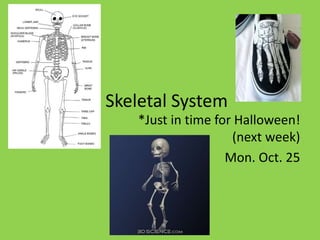
Skeletal system
- 1. Skeletal System *Just in time for Halloween! (next week) Mon. Oct. 25
- 2. Why learn about the skeletal system? • Framework for our body! – Like the frame for a building, it connects to, and holds up the rest of the body • Important functions (5): 1) Shape and support to body 2) Protects 1) Internal organs like brain, heart and lungs 3) Muscles are attached to bones 4) Blood cells are formed inside bones 5) Storage for important substances like calcium and phosphorus
- 3. What parts are included in the skeletal system? • Human skeleton is separated into 2 parts: 1) Bones of arms and legs 2) Bones of skull, spine, ribs
- 4. Bones • There are around 200 bones in the human body • Bone is ALIVE! Bones are dense organs made of layers of tissue • Many different sizes and shapes, depending on the function in human body (Fig. 18-2, go to pg.495) – All bones are not smooth: some have bumps, holes, rough spots, smooth spots
- 5. Bones continued… • Where two or more bones meet they form a JOINT ex. elbow, knee • Cartilage: Ends of bones are covered in cartilage – It is flexible and important at joints to help absorb shock – Makes movement easier • Ex: when you are playing sports and jump around, the cartilage absorbs the shock in your knees
- 6. Broken bones • Your bones are very strong, but even bones may break: ex. falling off a bicycle, horse • Breaking a bone is called a FRACTURE, and there are many different types • Blood cells move and create a clot between the space where the break is. Bone cells are then sent to this area and multiply to eventually repair the break
- 7. How do we keep our bones healthy? • Drink MILK! – Milk contains calcium, which helps to make bones strong – You have until you are about 19 years old to develop strong bones • Exercise – Build your muscles to help support your bones • When bones become weak: Osteoporosis – As all people get older, their bones become less dense – If someone has osteoporosis, their bones have become weakened, and these can break more easily
- 8. Activity: What shape are our bones? • Instructions: WITH YOUR GROUP, you will create different shapes to see which are stronger (can hold a textbook/binder), and relate this to the shape of our bones 1) Take half of your cardboard cards and tape to create a rectangular column 2) Take the other half of your cardboard cards and tape them to create a cylindrical (round) column 3) Place a binder or textbook on top of each column and observe which collapses first 4) Which is stronger? What is the shape of our bones? 1 2